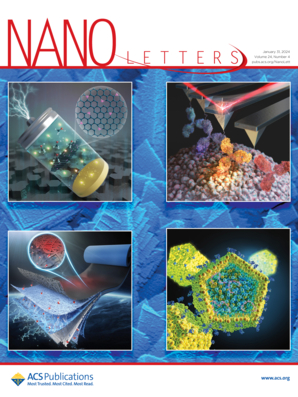Ultrathin, Stimuli-Responsive, Antimicrobial, Self-Cleaning, Reusable, and Biodegradable, Micro/Nanofibrous Electrospun Mat as an Efficient Face Mask Filter for Airborne Disease Prevention
IF 9.1
1区 材料科学
Q1 CHEMISTRY, MULTIDISCIPLINARY
引用次数: 0
Abstract
A multifunctional, electrospun, ultrathin face mask is desirable for preventing disease spread while ensuring breathability. However, balancing ultrathin construction with antimicrobial efficacy is challenging. Here, we fabricated an ultrathin micro/nanofibrous electrospun matrix, consisting of three biodegradable polymer layers, for high antibacterial efficiency, breathability, and biodegradability. The outer layer, with an average thickness of 9.01 ± 3.1 μm, is composed of polycaprolactone (PCL), silver nitrate (AgNO3), and β-cyclodextrin (β-CD). The middle layer, with a thickness of 4.61 ± 1.4 μm, comprises poly(vinyl alcohol) (PVA) and multiwalled carbon nanotubes (MWCNT) as a conductive layer. The inner layer, with a thickness of 5.12 ± 1.4 μm, contains PVA, carboxymethyl chitosan (CMC), and cellulose nanofibrils (CNFs) as a superabsorbent layer, supported by medical gauze. With a total thickness of ∼300 μm, the mask provides antibacterial efficacy, self-cleaning, reusability, mechanical stability, and biodegradability. This design advances filtering face masks, offering a solution to combat contagious diseases while minimizing environmental impact.

超薄,刺激响应,抗菌,自清洁,可重复使用,可生物降解,微/纳米纤维静电纺垫作为一种有效的面罩过滤器,用于预防空气传播疾病
多功能、静电纺丝、超薄口罩是防止疾病传播,同时保证透气的理想选择。然而,平衡超薄结构与抗菌功效是具有挑战性的。在这里,我们制作了一种超薄微/纳米纤维静电纺基质,由三个可生物降解的聚合物层组成,具有高抗菌效率,透气性和可生物降解性。外层由聚己内酯(PCL)、硝酸银(AgNO3)和β-环糊精(β-CD)组成,平均厚度为9.01±3.1 μm。中间层厚度为4.61±1.4 μm,由聚乙烯醇(PVA)和多壁碳纳米管(MWCNT)作为导电层组成。内层厚度为5.12±1.4 μm,由聚乙烯醇(PVA)、羧甲基壳聚糖(CMC)和纤维素纳米纤维(CNFs)作为高吸水性层,由医用纱布支撑。该口罩的总厚度为~ 300 μm,具有抗菌、自清洁、可重复使用、机械稳定性和生物降解性等优点。这种设计推动了过滤口罩的发展,提供了一种对抗传染病的解决方案,同时最大限度地减少了对环境的影响。
本文章由计算机程序翻译,如有差异,请以英文原文为准。
求助全文
约1分钟内获得全文
求助全文
来源期刊

Nano Letters
工程技术-材料科学:综合
CiteScore
16.80
自引率
2.80%
发文量
1182
审稿时长
1.4 months
期刊介绍:
Nano Letters serves as a dynamic platform for promptly disseminating original results in fundamental, applied, and emerging research across all facets of nanoscience and nanotechnology. A pivotal criterion for inclusion within Nano Letters is the convergence of at least two different areas or disciplines, ensuring a rich interdisciplinary scope. The journal is dedicated to fostering exploration in diverse areas, including:
- Experimental and theoretical findings on physical, chemical, and biological phenomena at the nanoscale
- Synthesis, characterization, and processing of organic, inorganic, polymer, and hybrid nanomaterials through physical, chemical, and biological methodologies
- Modeling and simulation of synthetic, assembly, and interaction processes
- Realization of integrated nanostructures and nano-engineered devices exhibiting advanced performance
- Applications of nanoscale materials in living and environmental systems
Nano Letters is committed to advancing and showcasing groundbreaking research that intersects various domains, fostering innovation and collaboration in the ever-evolving field of nanoscience and nanotechnology.
 求助内容:
求助内容: 应助结果提醒方式:
应助结果提醒方式:


